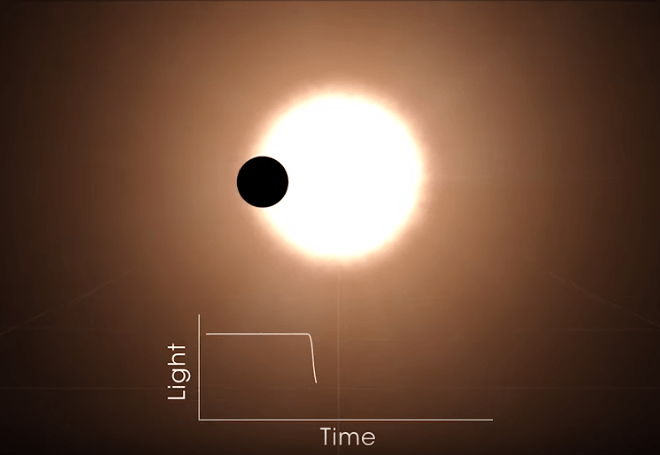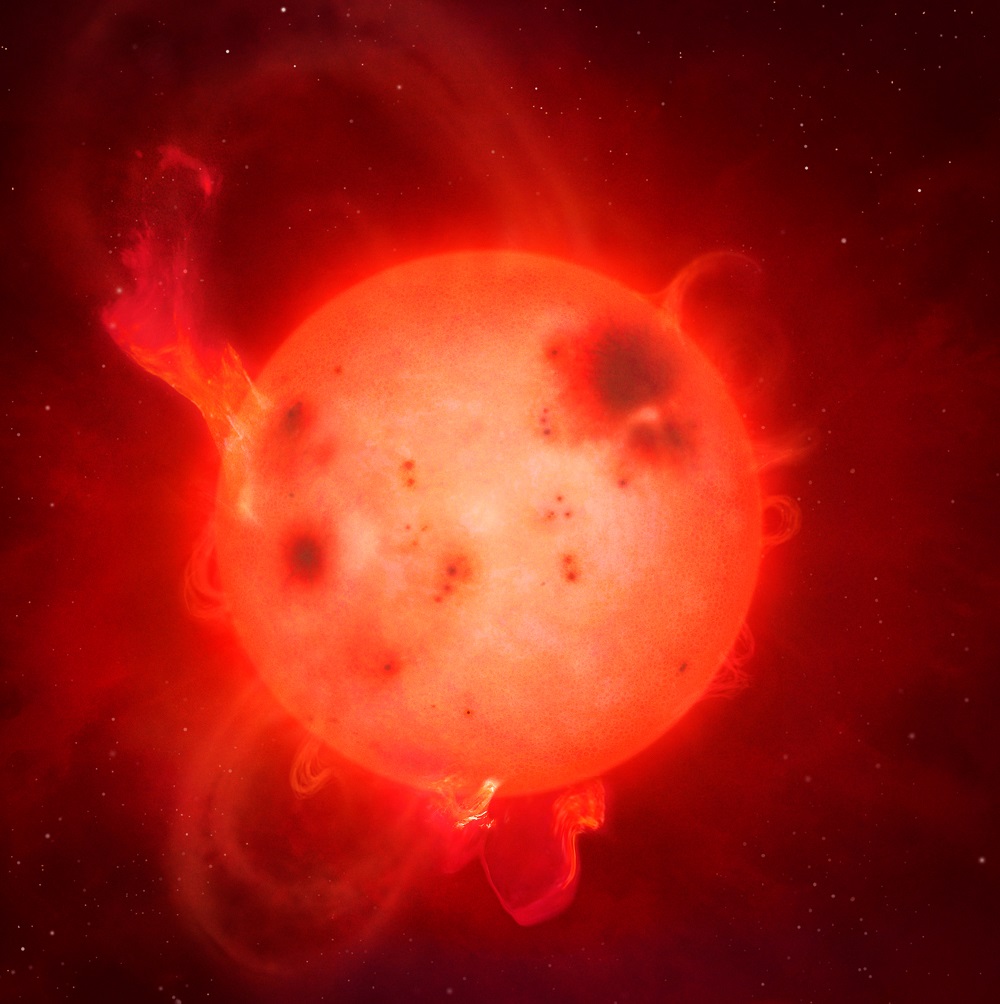Astronomers using the Hubble space telescope have discovered water in the atmosphere of an exoplanet in its star’s habitable zone. If confirmed, it will be the first time we’ve detected water—a critical ingredient for life as we know it—on an exoplanet. The water was detected as vapour in the atmosphere, but the temperature of the planet means it could sustain liquid water on its surface, if it’s rocky.
The planet is called K2-18b, and it’s about 110 light years away. The planet is much different than Earth. It’s a Super-Earth, and it’s twice as large as Earth, and about 8 times as massive. K2-18b is orbiting a red dwarf star, and it was first discovered in 2015 by the Kepler Space Telescope.
“Finding water on a potentially habitable world other than Earth is incredibly exciting.”
Dr. Angelos Tsiaras (UCL Centre for Space Exochemistry Data, CSED)
Astronomers at the Center for Space Exochemistry Data at the University College London in the United Kingdom made the discovery in data from the Hubble Space Telescope’s Wide Field Camera 3. Their results are in a paper titled “Water vapour in the atmosphere of the habitable-zone eight-Earth-mass planet K2-18 b” published in Nature Astronomy. The detection is based the spectroscopic signature of water in the exoplanet’s atmosphere.
In a press release, first author Dr. Angelos Tsiaras (UCL Centre for Space Exochemistry Data, CSED), said: “Finding water on a potentially habitable world other than Earth is incredibly exciting. K2-18b is not ‘Earth 2.0’ as it is significantly heavier and has a different atmospheric composition. However, it brings us closer to answering the fundamental question: Is the Earth unique?”
The team behind the discovery developed algorithms and ran archived Hubble data from 2016 and 2017 through them. They analyzed starlight from the red dwarf star as it passed through the exoplanet’s atmosphere. They discovered the molecular signature of water, as well as hydrogen and helium.

These results are yet to be confirmed, but if and when they are, the implications are intriguing. Scientists think that super-Earths like this one are the most common type of planet in the Milky Way. And red dwarf stars like the one K2-18b orbits are the most common type of star. They’re also the coolest and most long-lived, along with being the smallest. This indicates that there could potentially be many more exoplanets similar to this one.
Kepler discovered hundreds of Super-Earths, which are planets with masses between Earth and Neptune, and NASA’s TESS is expected to find hundreds more. According to the co-author of this new paper, Dr. Ingo Waldmann, this bodes well for finding potentially habitable exoplanets.
In a press release, Dr. Waldmann said, “With so many new super-Earths expected to be found over the next couple of decades, it is likely that this is the first discovery of many potentially habitable planets. This is not only because super-Earths like K2-18b are the most common planets in our Milky Way, but also because red dwarfs — stars smaller than our Sun — are the most common stars.”
The planet has a very short year. It takes only 33 days to complete one orbit. The researchers think that K2-18b is either a rocky planet, or an icy one. If it’s icy, it may have a large quantity of water in its interior. But these are just preliminary results.
“This study contributes to our understanding of habitable worlds beyond our Solar System and marks a new era in exoplanet research…”
DR. ANGELOS TSIARAS (UCL CENTRE FOR SPACE EXOCHEMISTRY DATA, CSED)
According to the authors, the atmosphere might also contain nitrogen and methane, two chemicals associated with life. But unfortunately they were unable to detect them. That’ll have to wait for further studies, which will also allow them to estimate cloud cover and the percentage of water in the atmosphere.
K2-12b is really close to its star, but because red dwarfs are not as energetic as our Sun, the exoplanet receives about as much energy as Earth does from our Sun. The astronomers’ calculations show that its temperature is similar to Earth’s: Somewhere in the range of about -72 Celsius to 47 Celsius (-99 degrees to 116 F.)
These are exciting results, but the prospects for life on this exoplanet are not great. Though the planet itself is in the star’s habitable zone, the star it orbits might not be very hospitable. Red dwarfs can emit lots of flares, and all that energy can severely limit the potential for life.

On the other hand, the fact that K2-12b has an atmosphere at all is exciting, especially since it contains lots of hydrogen. An atmosphere can protect a planet from a star’s radiation, just like Earth’s does. If the planet’s atmosphere is dominated by hydrogen, which is very light and easily dissipated by stellar radiation, it’s an indication that in some ways, K2-12b might be protected, even though it’s orbiting a red dwarf.
The size of K2-12b, and other Super-Earth’s, is also a factor in favour of habitability. “Water can stay quite long because super-Earths can retain their atmosphere for a longer time, because they have a bigger gravity,” Giovanna Tinetti, a physicist who co-authored the paper, said in a press call.
“This study contributes to our understanding of habitable worlds beyond our Solar System and marks a new era in exoplanet research, crucial to ultimately placing the Earth, our only home, into the greater picture of the Cosmos,” said Dr Tsiaras.

This discovery needs follow-up observations to confirm it. We also need better telescopes to study its atmosphere in greater detail, and the atmospheres of other exoplanets. Two telescopes on the horizon will tackle that job. The James Webb Space Telescope will have the powerful capability to examine the atmospheres of exoplanets, which is really the next step in understanding all of the exoplanets found by Kepler, and which will be found by TESS.
The ESA’s ARIEL (Atmospheric Remote-sensing Infrared Exoplanet Large-survey) mission will launch in 2028 and will study the atmospheres of about 1000 exoplanets in detail. ARIEL, along with the JWST, will give us a much better understanding of K2-12b and exoplanets like it.

Professor Giovanna Tinetti (UCL CSED), co-author and Principal Investigator for ARIEL, said: “Our discovery makes K2-18b one of the most interesting targets for future study. Over 4000 exoplanets have been detected but we don’t know much about their composition and nature. By observing a large sample of planets, we hope to reveal secrets about their chemistry, formation and evolution.”
“To actually understand how habitability evolves in a hydrogen-rich atmosphere is going to be a very intense subject of study over the next 10 years,” said Waldmann.
More:
- Research Paper: Water vapour in the atmosphere of the habitable-zone eight-Earth-mass planet K2-18 b
- NASA Press Release: NASA’s Hubble Finds Water Vapor on Habitable-Zone Exoplanet for 1st Time
- Hubble Press Release: Hubble Finds Water Vapor on Habitable-Zone Exoplanet for the First Time

